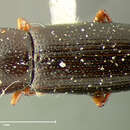Conservation Status
provided by University of Alberta Museums
Not known to be rare in North America.
- license
- cc-by-nc
- copyright
- University of Alberta Museums
Cyclicity
provided by University of Alberta Museums
Adults of R. remotus have been collected in Alberta from May through September.
- license
- cc-by-nc
- copyright
- University of Alberta Museums
Distribution
provided by University of Alberta Museums
Distribution of North American collected specimens is clustered along the southeastern coast of Canada and the northeastern coast of the United States. The eastern distribution continues west to Manitoba and possibly further south in the US (Bousquet, 1990). Western populations extend from Alaska through California, extending east to Alberta and south to Arizona and New Mexico (Bousquet, 1990).
- license
- cc-by-nc
- copyright
- University of Alberta Museums
General Description
provided by University of Alberta Museums
All Rhizophagus spp. have antennal grooves on either side and slightly under the head (Bousquet, 2004). Body is fairly flattened, elongate and small, under 4.5 mm in total length (Bousquet, 2004). The final abdominal tergite (the last segment visible dorsally) is not covered by elytra (Sengupta, 1988). Larvae may be 2-6 mm in length and flat or cylindrical or tapered at both ends (Lawrence, 1991).The pronotum, the section of dorsal exoskeleton directly behind the head, is shorter and wider than in other species and the entire body is slightly wider (Bousquet, 1990). Rhizophagus remotus have their 11th antennal segment visible at the end of the club (Bousquet, 1990), similar to R. dimidiatus.
- license
- cc-by-nc
- copyright
- University of Alberta Museums
Habitat
provided by University of Alberta Museums
Under the bark of coniferous and deciduous trees (Bousquet, 1990).
- license
- cc-by-nc
- copyright
- University of Alberta Museums
Life Cycle
provided by University of Alberta Museums
Colours of parts of the exoskeleton and patterns of the divets on the pronotum may allow for the separation of eastern and western specimens, but a large amount of variability is still present (Bousquet, 1990). Catch of R. remotus in window traps in forested northern Alberta tends to be fairly consistent (but not abundant in comparison to other Rhizophagus species) through spring and summer (J. Jacobs, pers. comm.).
- license
- cc-by-nc
- copyright
- University of Alberta Museums
Trophic Strategy
provided by University of Alberta Museums
Many specimens have been collected under the bark of pine (Pinus spp.) and often trembling aspen (Populus tremuloides Michx.). Due to this deciduous presence, it is likely that R. remotus feeds more heavily on decaying material than other bark beetle predators in this genus.
- license
- cc-by-nc
- copyright
- University of Alberta Museums
Rhizophagus remotus
provided by wikipedia EN
Rhizophagus remotus is a species of root-eating beetle in the family Monotomidae. It is found in North America.[1][2][3]
References
- license
- cc-by-sa-3.0
- copyright
- Wikipedia authors and editors
Rhizophagus remotus: Brief Summary
provided by wikipedia EN
Rhizophagus remotus is a species of root-eating beetle in the family Monotomidae. It is found in North America.
- license
- cc-by-sa-3.0
- copyright
- Wikipedia authors and editors

